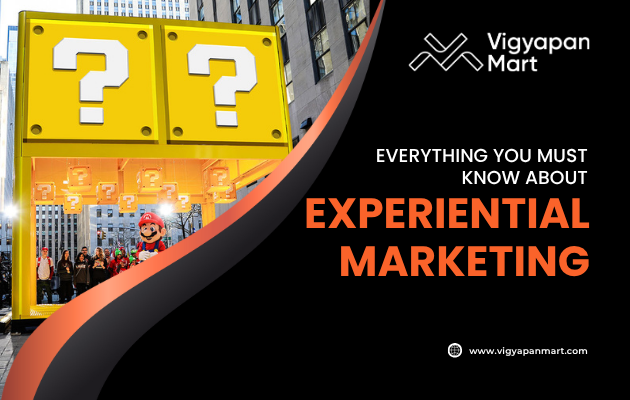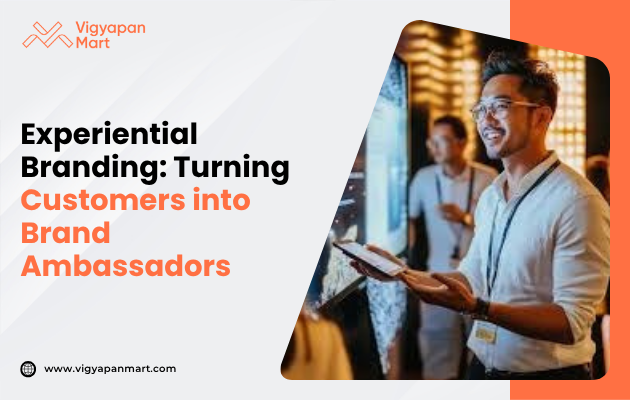Everything You Must Know About Experiential Marketing

Among all the outdoor advertising, experiential marketing is most probably the most unique one. It offers you unlimited creativity through real-life immersive experiences. Unlike their counterparts which are passive and one-way in nature, experiential marketing engages with the brand actively and lets the participant experience the products. But what are they? Learn everything about experiential marketing in this blog.
What is Experiential Marketing?
Experiential marketing, also known as engagement or event marketing, aims to provide audiences with unique, branded experiences. But what’s the goal? To know how customers see a brand and their buying habits through active participation. Unlike traditional marketing, experiential marketing brings brands to life in physical spaces and creates something real and relatable. They stimulate multiple senses, tailor experiences, and cultivate deeper & more personal relationships with potential customers. These marketing campaigns come in various forms, such as
- Live events,
- Pop-ups,
- Product demos, and
- Sponsorships.
For example-
- A car brand might host a test drive event for people to experience their vehicles.
- A beverage company can create a pop-up bar showcasing its products in a fun, interactive way.
Why Experiential Marketing?
Here are some facts that are often ignored:
- Experiential marketing helps to create an emotional connection with customers through memorable experiences.
- It actively engages the audience, encouraging them to participate in a brand experience event live.
- Experiential advertising efficiently engages consumers, raises brand awareness, encourages word-of-mouth, and boosts sales.
- These events don’t just entertain, they gather valuable data and insights about audiences. Brands can use it to fine-tune their follow-ups and marketing strategies.
Statistics about Experiential Marketing
- 91% of consumers say that they would feel more optimistic about a brand if they engage with a brand’s products or services.
- 40% of the customers agree that experiential marketing makes them more loyal.
- 70% of consumers become repeat customers after engaging with a brand.
- 9 out of 10 consumers love experiencing a product.
- 78% of millennials prefer brand experience before purchasing a product.
Examples of Experiential Marketing
- Lipton Ice Tea Lipton’s campaign offered a refreshing spray of water mist to cool people down in the scorching heat.
- Live Angry Birds T-Mobile created a live-action Angry Birds environment in Barcelona, Spain, allowing people to interact and enjoy the game in real life.
- Yogurt Wars: Yoplait launched a pop-up shop in New York’s SoHo area to promote its Yoplait Greek yogurt and invited customers to a blind taste test.
- Coca-Cola’s “Hug Me” campaign Coca-Cola’s “Hug Me” campaign was a playful and loving reminder of the power of the human touch.
- ASICS Run with Ryan ASICS launched a compelling experiential marketing campaign called “Run with Ryan” in the lead-up to the New York City Marathon.
- McDonald’s Save the Sundae Cone This innovative campaign titled ‘Save the Sundae Cone‘ was launched in Malaysia in January 2014 by McDonald’s.
Elements of Successful Experiential Marketing Campaigns
- Ensure that the activation represents your marketing campaigns well. Clearly show who is hosting the event, and the campaign should be relevant to the brand.
- The experience should be memorable, engaging customers in ways beyond standard advertisements.
- It is important to measure the success of experiential marketing campaigns through methods like headcount, post-event surveys, and social media engagement.
- If you’re hosting online experiences, it can be tracked using click-through rates, views, and return on ad spend.
Conclusion
Experiential marketing allows brands to go beyond the traditional one-way advertising methods. It takes real-life spaces and makes a brand more personal to people. The audiences can experience their products or services, making customers feel more valued and respected. This significantly enhances the brand’s perception among the public.
Customer-focused experiences offer an opportunity to differentiate their products, voice, and identity. Are you looking for better customer engagement and brand awareness through experiential marketing? You need an expert here! Connect with Vigyapan Mart and have personalized consultation, a step-by-step guide, and the best experiential marketing services for your brand.









